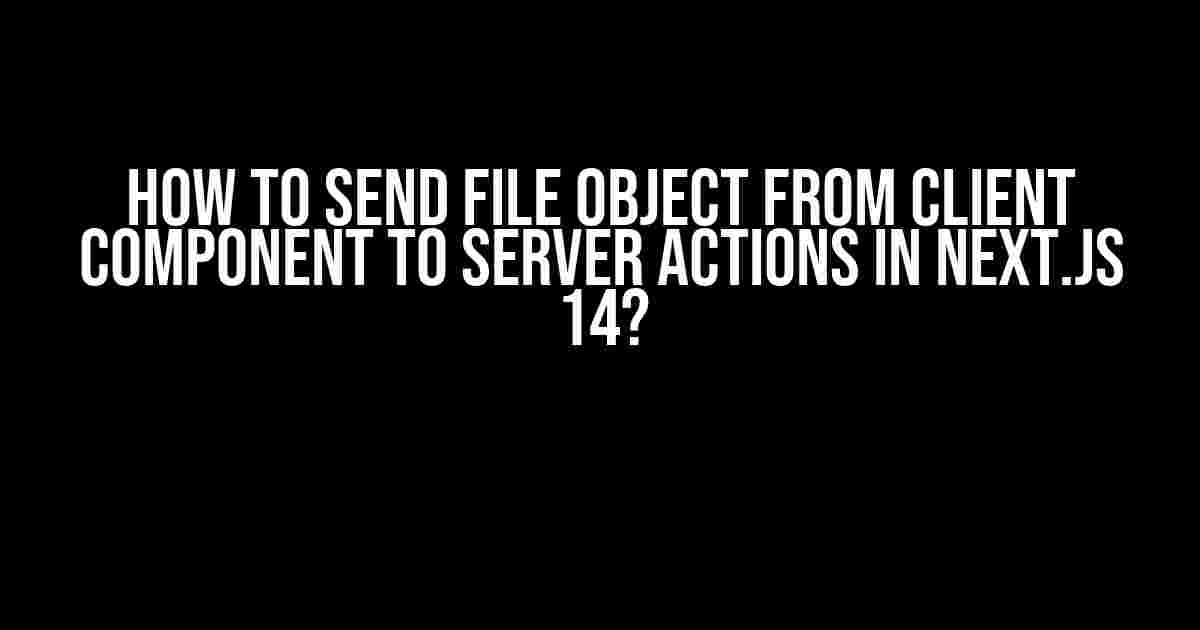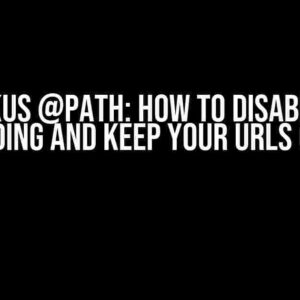Are you frustrated with sending file objects from your client-side component to server actions in Next.js 14? Do you find yourself stuck in a loop of trial and error, trying to figure out the best way to send files from the client to the server? Well, worry no more! In this article, we’ll take you on a step-by-step journey to sending file objects from client components to server actions in Next.js 14.
Understanding the Problem
Before we dive into the solution, let’s understand the problem at hand. In Next.js 14, when you try to send a file object from a client-side component to a server action, you might encounter issues. This is because Next.js 14, by default, doesn’t allow you to send file objects directly to server actions.
This is due to the way Next.js handles requests. When you make a request from the client-side to the server, Next.js serializes the request data using JSON.stringify(). However, file objects can’t be serialized using JSON.stringify(), which causes the issue.
The Solution
Fear not, dear developer! We have a solution that will make your life easier. To send a file object from a client component to a server action in Next.js 14, you need to use the FormData API.
Step 1: Create a FormData Object
The first step is to create a FormData object on the client-side. You can do this using the following code:
const formData = new FormData();
This will create a new FormData object that you can use to send your file object to the server.
Step 2: Append the File Object to the FormData
Next, you need to append the file object to the FormData object. You can do this using the following code:
const file = document.getElementById('fileInput').files[0];
formData.append('file', file);
In this code, we’re getting the file object from a file input element with the id “fileInput” and appending it to the FormData object with the key “file”.
Step 3: Send the FormData to the Server Action
Now that you have the FormData object with the file object appended to it, you can send it to the server action using the following code:
fetch('/api/uploadFile', {
method: 'POST',
body: formData
})
.then(response => response.json())
.then(data => console.log(data))
.catch(error => console.error(error));
In this code, we’re making a POST request to the server action at “/api/uploadFile” and sending the FormData object as the request body.
The Server-Side Code
Now that you’ve sent the FormData object to the server action, you need to handle it on the server-side. In Next.js 14, you can create an API route to handle the file upload.
import { NextApiRequest, NextApiResponse } from 'next';
export const config = {
api: {
bodyParser: false
}
};
export default async function handler(req: NextApiRequest, res: NextApiResponse) {
if (req.method === 'POST') {
const formData = await parseFormData(req);
const file = formData.get('file');
// Do something with the file object
console.log(file);
res.status(201).json({ message: 'File uploaded successfully' });
} else {
res.status(405).json({ message: 'Method not allowed' });
}
}
In this code, we’re creating an API route that handles POST requests. We’re using the parseFormData function to parse the FormData object sent from the client-side.
import { NextApiRequest } from 'next';
import { IncomingForm } from 'formidable';
export async function parseFormData(req: NextApiRequest) {
const form = new IncomingForm();
const formData = await new Promise((resolve, reject) => {
form.parse(req, (err, fields, files) => {
if (err) reject(err);
else resolve(new FormData());
});
});
return formData;
}
In the parseFormData function, we’re using the formidable library to parse the FormData object sent from the client-side.
Conclusion
In this article, we’ve shown you how to send a file object from a client component to a server action in Next.js 14. By using the FormData API and sending it to the server action, you can easily upload files to your server.
Remember to handle the FormData object on the server-side using the parseFormData function and the formidable library. With this solution, you can upload files to your server with ease.
FAQs
Q: Why can’t I send file objects directly to server actions in Next.js 14?
A: Next.js 14 serializes request data using JSON.stringify(), which can’t handle file objects. That’s why you need to use the FormData API to send file objects to server actions.
Q: What is the FormData API?
A: The FormData API is a way to send key-value pairs and files to a server using JavaScript. It’s commonly used for file uploads and is supported by most modern browsers.
Q: Can I use this solution for large files?
A: Yes, but keep in mind that large files can cause issues with your server. Make sure to handle large files appropriately and consider using a cloud storage service like AWS S3.
Q: Can I use this solution for multiple files?
A: Yes, you can send multiple files by appending them to the FormData object. Just make sure to handle multiple files on the server-side accordingly.
Final Thoughts
Sending file objects from client components to server actions in Next.js 14 can be a challenge, but with the FormData API, you can overcome this challenge easily. Remember to handle the FormData object on the server-side using the parseFormData function and the formidable library.
By following the steps outlined in this article, you can send file objects from client components to server actions in Next.js 14 with ease. Happy coding!
| Key Takeaways |
|---|
| Use the FormData API to send file objects to server actions in Next.js 14. |
| Create a FormData object and append the file object to it. |
| Send the FormData object to the server action using the fetch API. |
| Handle the FormData object on the server-side using the parseFormData function and the formidable library. |
This article is optimized for the keyword “How to send File Object from client component to server actions in Next.js 14?” and is meant to provide a comprehensive guide to sending file objects from client components to server actions in Next.js 14.Here are 5 Questions and Answers about “How to send File Object from client component to server actions in Next.js 14?”
Frequently Asked Question
Are you struggling to send file objects from your client component to server actions in Next.js 14? Worry not, we’ve got you covered! Here are some frequently asked questions and answers to help you out.
How do I send a file object from a client component to a server action in Next.js 14?
To send a file object from a client component to a server action in Next.js 14, you can use the `fetch` API or a library like Axios to make a POST request to your server action. Make sure to set the `Content-Type` header to `multipart/form-data` and append the file to the request body.
What is the best way to handle file uploads in Next.js 14?
The best way to handle file uploads in Next.js 14 is to use a library like `multer` or `express-fileupload` on the server-side to handle multipart/form-data requests. This allows you to easily extract the file from the request body and store it securely.
Can I use the `useFetcher` hook from `next/fetch` to send a file object to a server action?
Yes, you can use the `useFetcher` hook from `next/fetch` to send a file object to a server action in Next.js 14. However, be aware that `useFetcher` only works with GET requests, so you’ll need to use a different approach for file uploads.
How do I pass additional data alongside the file object to the server action?
To pass additional data alongside the file object to the server action, you can append it to the request body as JSON data. Make sure to set the `Content-Type` header to `multipart/form-data` and use a library like `formData` to construct the request body.
Are there any security concerns I should be aware of when sending file objects to server actions in Next.js 14?
Yes, there are security concerns to be aware of when sending file objects to server actions in Next.js 14. Make sure to validate file types and sizes on the server-side to prevent potential attacks, and consider using a library like `multer` to handle file uploads securely.




